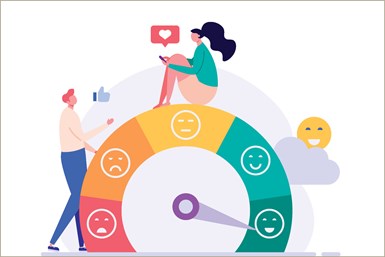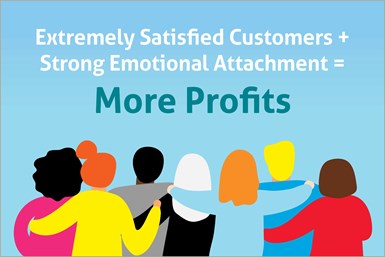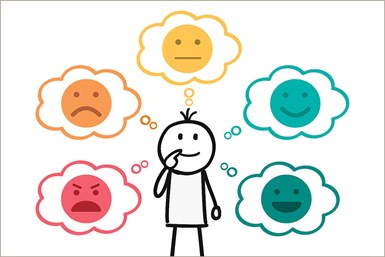Measuring Customer Loyalty Regarding Brand and Insistence
An approach that seems to help understand customer behavior regarding brand loyalty and insistence is the work done by experts who look at customer brand involvement as a combination of involvement and emotional content. An understanding of customer behavior finds that insistence for brands will vary based on either the brand's personality or the brand's reflection of the buyer's personality. There is an important distinction between identification with a brand and a belief that the brand identifies with you.
#brandbuilding
Part 3 of a 3-Part Series
By Mitchell Goozé, Principal
Customer Manufacturing Group

Measuring attitudinal issues such as loyalty is difficult. Studies by Gallup found that companies often define customer loyalty incorrectly. This leads to erroneous and unprofitable actions.
These Gallup studies also corroborate earlier research, which found that attempting to define customer loyalty solely by customer repeat purchase behavior is misleading. Often, repeat purchase behavior is not the result of loyalty, but rather bribery. Offers of gifts, discounts or other purchase rewards are the purchase motivator . . . not loyalty or insistence.
For example, frequent buyer programs do not create loyalty . . . they merely condition buyer's behavior. That behavior changes when a better premium comes along. Meaning that no loyalty was built . . . and therefore no increase in brand equity!
Consider the fact that most airlines will "comp" your status in their program for the first year to equal that of the program you are leaving. In other words, they will "match the bribe" if you will "move your loyalty." The sad truth is that numerous research studies have found that bribery-based loyalty is not loyalty, and further it has been shown to reduce actual loyalty both behaviorally and attitudinally.
Measures of loyalty based solely on purchase behavior are often misleading because the company can't differentiate between customers who are brand loyal and those with no real commitment.
The uncommitted appear loyal so long as the bribes continue. Alternatively, the bribes may stop, and purchase behavior may continue out of habit, but only until an alternative brand offers a purchase incentive. This is not building brand loyalty, but rather disguising a "discount program" as brand building. It is in fact brand "un-building."
Companies have attempted to measure customer loyalty based on customer satisfaction scores. Research by several organizations found, consistently, that satisfied customers leave . . . often. Several experts suggest that the key to brand loyalty and/or insistence is "emotional attachment" to the brand. Assuming that is correct, how would you measure "emotional attachment" (which is clearly attitudinal)? High involvement, as discussed above, is probably necessary for "emotional attachment," but it is insufficient.
Emotional Attachment

Does emotional attachment correlate to higher value? Again, using Gallup studies, it has been shown that, across a broad spectrum of business types, so called "extremely satisfied customers" and those who were not extremely satisfied spent about the same amount of money with the supplier. However, if the additional factor of "emotional attachment" was added, then extremely satisfied customers who had strong emotional attachment were substantially more profitable. Could emotional attachment be a proxy for loyal and/or insistence? Perhaps.
Understanding emotional attachment can help explain what appears to be "unexplained behavior." Examples of emotional attachment that correlate to unexplained behavior can be seen in such cases as the failure of New Coke.
The Coca Cola Company had ample research that "proved" that New Coke tasted better than Classic Coke to most cola drinkers. This "proof" prompted them to reformulate Coca Cola and announce this improved new product. Imagine their shock when the new product was received with a resounding rejection.
They had failed to recognize that their core customers were loyal and insistent due to an emotional attachment to Coca Cola. If you change the formula, it is no longer Coca Cola . . . thus breaking the emotional bond, even if the new product "tasted better."
Assuming emotional attachment is measurable (either using the Gallup scale or others), and emotional attachment is a proxy for loyalty and insistence, then the next question is how is emotional attachment created? Why do people tattoo the Harley Davidson logo on their bodies? Why will a Vernor's insistent loyalist drive 100 miles in his pick-up truck to get to the nearest Vernor's retailer rather than settle for another brand of ginger ale? Like everything else in business, it starts with an understanding of the customer.
Creating Brand Insistence

The fundamental job of Marketing is to understand What the customer believes they can buy from your "brand" that they don't believe they can buy from any other product or service. It is simply remembering that the core job of Marketing cannot be done without "thinking like the customer."
Some experts state that emotional attachment to brands across whatever spectrum you choose to measure occur with people because:
1. The brand stands for something that is important to them
2. The brand connects with them on multiple levels across several senses
3. The brand is (or at least appears to be) unique.
4. The brand is admirable
5. The brand interacts with them and does not disappoint them
6. The brand makes them feel good
If you consider these six items in the frames of involvement and emotional context, there are simple ways to identify and enhance involvement and emotional attachment. Clearly, how these attachments are achieved in a business-to-business environment will be different than in a business-to-consumer environment, but they are no less necessary.
If we cycle back to an earlier concept, "brand personality," it becomes clearer that emotional attachment to a brand personality can be understood and appreciated. The key to brand loyalty and insistence is to understand whom you are trying to attract with your brand (your Who); What they are needing and wanting to buy, and then create a brand personality that they can form an emotional attachment to, and voila . . . you will achieve brand loyalty and insistence. Assuming you don't screw it up by messing with success, you will reap the benefits that come from a group of customers whose loyalty includes an insistence for your brand.
Final Thoughts
While still not as easy to measure as you might prefer, clearly brand insistence is the goal. Developing high emotional attachment between your customers and your brand is the way to achieve that goal. However, in your zeal to prove brand insistence, recognize that the shortcut of increasing purchase persistence does not necessarily create brand insistence and in fact is likely to do the opposite. If your goal is to build long-term brand equity, there is no substitute for true brand insistence.
Need more information?
Mitchell Goozé, Principal
Customer Manufacturing Group
225 Gregorgio Court
Reno, NV 89521
408-987-0140
LinkedIn
800-947-0140
Fax: 408-727-3949
About the Author
Mitch Goozé
A recognized expert in marketing, innovation and leadership, strategic positioning, and customer relationships, Mitch Goozé has addressed groups throughout the world. Mitch is an experienced general manager and leader with operating experience in the high technology and consumer products industries. He has experience running divisions of large companies, as well as being CEO of mid-sized companies. Mr. Goozé was president of Teledyne Components, a division of Teledyne, Inc. for five years.
Mitch is a Certified Speaking Professional (CSP). Vistage, an international organization of CEOs, named him Marketing Resource of the Year. He was named Speaker of the Year 2001 by TEC UK.
Mitch was a major contributor to Future In Sight, (Macmillan, 1995) and has three books on marketing in print. He has been a member of Customer Manufacturing Group since 1991. Customer Manufacturing helps its customers increase marketing/sales performance through process improvement management.
RELATED CONTENT
-
Understanding Brand Affinity
An approach that seems to help understand customer behavior regarding brand loyalty and insistence is the work done by experts who look at customer brand involvement as a combination of involvement and emotional content. An understanding of customer behavior finds that insistence for brands will vary based on either the brand's personality or the brand's reflection of the buyer's personality. There is an important distinction between identification with a brand and a belief that the brand identifies with you.
-
Brand Insistence Vs. Brand Loyalty
While it may be difficult to determine if you have achieved true, valuable brand loyalty, it is not impossible. Here’s a look at an important issue in terms of achieving true brand value.
-
Brand vs. Product Advertising. What’s the Fuss?
Marketers have long debated the merits of brand vs. product advertising. In truth, there are reasons for both. The strategy depends on the marketing situation.


